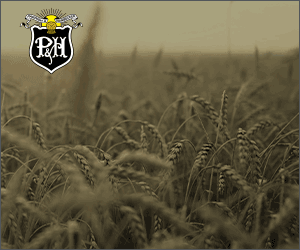Research Roundup
FIND OUT WHAT’S NEW IN THE WORLD OF RESEARCH
Planting wheat using the best technique
Rebecca Hannam
Wheat growers have reported increased yields in headland areas where seeding may be overlapped. These reports spurred researchers to investigate the potential benefits of double seeded wheat in Ontario.
However, Peter Johnson, cereal specialist with the Ontario Ministry of Agriculture, Food and Rural Affairs, has shown that purposely using the double seeded technique for planting wheat does not increase yield.
Research was conducted across southwestern Ontario through planting double seeded wheat on angles, and closely monitoring yield and soil conditions. Johnson says no yield gain was shown in any of the field trials compared to single seeded wheat.
In fact, significant yield reductions were observed when double seeding techniques were used in soil that was almost too wet to be seeded.
This research was funded by the Agricultural Adaptation Council’s Farm Innovation Program, the Grain Farmers of Ontario and the Middlesex Soil and Crop Improvement Association. •
Trials successful for soybean aphid management tool
Rebecca Hannam
Battling soybean aphid populations has been a concern for Ontario growers since 2000. These invasive pests are usually controlled by crop protection products. But researchers at the University of Guelph have created a new tool that will incorporate natural enemies – that is, insect predators and parasitoids living in the field – for improved aphid management.
Dr. Rebecca Hallett, School of Environmental Sciences, has successfully developed a tool used for calculating the dynamic action threshold (in other words, the number of aphids that warrant spraying in conventional soybeans, based on the presence or absence of natural enemies in the field).
The calculator has been converted into a hand-held disk-style tool that will make it easy for growers to use in the field.
“Keeping the potential impact of natural insect predators in mind when making spraying decisions can lead to environmental and economic benefits, and our trials show that natural enemies can greatly limit soybean aphid populations,” says Hallett.
The hand-held tool was used in three field trials in the 2009 growing season. It proved to decrease the amount of insecticide spray applied without compromising yield. Hallett says the tool should be available to Ontario growers and crop consultants this year.
Funding for this project was provided by Agriculture and Agri-Food Canada’s Pesticide Risk Reduction Program and the Grain Farmers of Ontario. •
Post-emergent product controls wirestem muhly in corn
Carolynn Seaton
Research shows the post-emergent herbicide Option provides excellent control of wirestem muhly in corn. Wirestem muhly is a perennial grass native to North America and a problem weed in southwestern Ontario.
Dr. Peter Sikkema and Joshua Vyn of the University of Guelph’s Ridgetown Campus and Jim Kells of Michigan State University evaluated sulfonylurea herbicides for wirestem muhly control. Option is rapidly absorbed throughout the plant, and is applied in low doses.
“Because wirestem muhly emerges late in the season, pre-plant burndown herbicide applications are ineffective because the grass hasn’t emerged at the time of application,” says Sikkema.
To determine the best control options for corn producers, the researchers evaluated five sulfonylurea herbicides: Elim EP, Accent, Ultim, Option and Summit. Of these five, only Option demonstrated effective control against wirestem muhly.
This research has been funded by the Grain Farmers of Ontario, CanAdvance and Bayer CropScience. •
Research Roundup is provided by members of SPARK (Students Promoting Awareness of Research Knowledge) at the University of Guelph’s Office of Research. For more information, contact a SPARK writer at 519-824-4120, ext. 52667.








